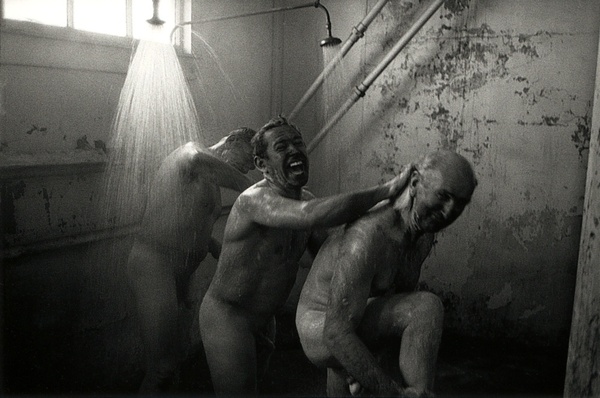briefs
2017-08-16
Underground coal miners

Denniston, Westland, New Zealand, 1981
From the archives, after a peep last week at Domestic Scene: Los Angeles 1963, a shower painting in the David Hockney show, Centre Pompidou.
Bathhouse, Denniston, Westland, New Zealand, 1981 from the 1986 project ‘Beyond the Pale’. The full series was exhibited at the Dowse Art Museum under ebullient director James Mack, and is in their permanent collection. It was exhibited too at the Auckland Art Gallery, 1990, and various locations amongst the coal miners themselves, including the Rununga Working Men’s Club and the Whataroa School hall.
I wrote the following abridged story for the New Zealand Listener magazine, 20 August 1988, to coincide with the opening of ‘Beyond the Pale’ ...
COALFACE CLOSE UP
My Uncle Jimmy died in 1984 shortly before he was to retire as Chief Inspector for Coal Mines. He first took me down a coal mine up in the clouds at Denniston 24 years ago. I was comfortable underground although I had not yearned to be a coal miner, and still don’t. My grandfather Fred Connew, my uncle’s father, worked underground at Denniston and Stockton in the earlier part of the century and on the locomotives too out of the Stockton mine to the rope road. He was president of the Stockton Miners Union for 30 years. Great Uncle Joe worked the middle break on the Denniston incline.
As a 14-year-old boy, my father, Keith (also known as Fred), walked up the incline behind Ngakawau every morning for months before being taken on, to follow the early morning deputy who checked the mine’s safety before the day shift. Sometimes, he had to dig out Mr Rees as he only dared call him when the deputy’s prodding checks of the roof brought an unsafe section down around his ears. Dai Rees taught my father to waltz during several of these early morning inspections.
After not too many months, Dad, who tells a good story, preferred the bowels of a ship to the bowels of the earth, left the mine and joined the navy. He stayed with the navy almost as long as my uncle, his brother, did with State Coal.
Outside of their communities, there is nowadays, scant fellow-feeling for the coal miner. In the city, the miners’ hard labour produces less a feeling of awe than a fascination at the antiquity of their task. If grubbing about beneath ground in a “cosy sort of hell” isn’t seen as an anachronism, certainly hard labour as a livelihood is.
This, the archetypal working class, has seen its emotional influence dwindle as steadily as it’s numbers and along with its political and economic power. The dubious mantle of masculinity for so long fastened to the glory of labour as personified by miners and their sweat has shifted to the money of the city (line from a recent Coalcorp advertisement: When you deal with Coalcorp you are dealing with professional people who wear suits) and the exulted urban athlete.
A prolonged photographic project—this one was five months—provides scope to explore beyond the narrow preconceptions of a magazine’s needs and to consider otherwise ill-considered themes. Who would have guessed that in this decade of men’s groups that for the better part of the century miner’s have been washing the coal and sweat from each other’s backs?
In a recent television sponsorship advertisement for Steinlager beer and the All Blacks rugby team, a miner’s pick fleetingly slams into coal amid powerful, sweaty, rugby bodies (Orwell’s “splendid” bodies!) exploiting, with nostalgia and sentimentality, the intimacy of shared danger and common effort. The final seven photographs in the exhibition turn that not-to-be-discounted mateship stereotype on its head through the imagery of aloneness, and steadily work back towards that intimacy of comradeship.
Photography has the facility to be a true account of a certain moment in time while, at once, remaining aloof from the context of the moment. The photograph of Penthouse nakedness pinned eloquently across a grubby beam with the word WINCH chalked at one end is proof in itself that that moment in time did exist. Beyond the existence of that moment, ripe for interpretation, is the ambiguity of photography.
Fundamental to that ambiguity are the visual symbols carefully included (and excluded) by the photographer at the time of exposure and later at the editing and sequencing stage for the gallery walls (or book or magazine): his bias. How the viewer now interprets this photograph and the others and connects one with the other is dependent upon the viewer’s assumptions, social conditioning, morality and even which side of the bed he/she climbed from that morning.
BRUCE CONNEW / 08.1988